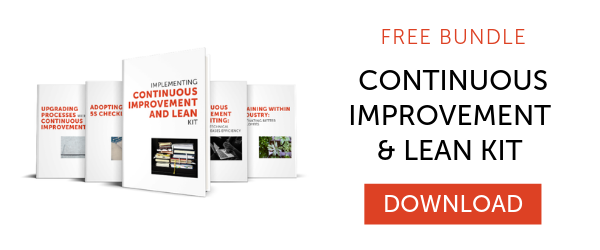
Continuous Improvement
7 min read
How to Create a Culture of Knowledge Sharing and Continuous Improvement

If a proper culture of knowledge sharing is in place, the skills that experienced employees possess can be leveraged to improve your business and culture. Every manager knows that experienced employees are relied on more often than not. These are your go-to people, the rainmakers, the skilled superstars of your business. When you have a problem, they have the skills and experience to step to the challenge.
But relying on these superstars to accomplish everything isn’t utilizing their talents effectively. Continuous improvement is an ongoing practice that should elevate everyone in your organization, not just the superstars — effective knowledge sharing is the first step.
Continuous Improvement: No Longer an Option
Advancements in manufacturing technology are progressing at a much faster rate and the supporting skills are changing in tandem. According to a recent LinkedIn research piece, half of today’s most in-demand skills weren’t even around three years ago. This means that striving for continuous improvement is no longer an option. As a result, creating an effective culture of knowledge sharing will be mandatory in order to remain competitive.
Knowledge Sharing vs. Information Transfer
Knowledge sharing is defined as a mutually beneficial exchange of ideas between two or more parties. Merely transferring information can be helpful, but doesn’t improve collective knowledge in a way that benefits the entire company.
Knowledge Sharing - a mutually beneficial exchange of ideas between two or more parties.
In this light, knowledge sharing is a reflection of company values and culture. It’s up to leaders to create an environment where this type of culture thrives—providing the fuel for continuous improvement. With the proper tips and tools, you too can optimize your business and create a culture of knowledge sharing and continuous improvement.
How to Create a Culture of Knowledge Sharing
1. Learn to Value Organizational Knowledge Over Individual
A fundamental problem with organization knowledge is that many people believe having more knowledge than your colleague gives you power. Some employees may feel that the knowledge they possess is theirs and theirs alone, giving them a false sense of insurance or entitlement.
The key here is to educate these employees and replace their assumption of “knowledge is power,” with “sharing knowledge is power.” This requires communicating to employees that:
Sharing knowledge is a synergistic process
When an employee shares knowledge, they gain more than they lose. The act of sharing knowledge helps to form and expand even greater ideas.
Successful production requires a collaborative effort
Hoarding knowledge is a recipe for disaster. When knowledgeable employees are open and share with others, they receive support and buy-in and this helps the knowledgeable employee achieve their own career objectives.
Sharing knowledge helps careers
Knowledge is perishable. It is short-lived and loses its value over time, particularly when it is not shared. Those who share their knowledge actually perform their jobs more effectively, and improve personal development and recognition.
Explain to the knowledge holder that sharing knowledge helps them to perform better at their jobs and that the ultimate goal is to achieve success as a team. Sharing what they know makes the company stronger and improves their standing in the organization.
2. Demonstrate Leaders Sharing Knowledge
Sometimes employees won’t share their knowledge because of a lack of support from the organization’s leaders. Because leaders can also be guilty of holding knowledge close to the chest, when they share, they set an example for others to do the same. The fear of losing power disappears when employees witness management members sharing valuable, helpful information.
When executives lead by example in knowledge sharing, the company experiences increased innovation, productivity, collaboration, and employee engagement. Business leaders must drive the effort of knowledge management and encourage employees to share their wealth of experience and information.
7 Strategies for Leaders to Demonstrate Knowledge Sharing
1. Ask questions and solicit feedback
Break the ice by seeking to learn what it is employees want to know or what they need to succeed
2. Tell people what you are doing
Let them know why you are doing something a particular way
3. Ask people what would they do differently
We can always learn from others. Seek to find out why a procedure or function is done in a certain way, then offer your insights if necessary.
4. Ask other people for help
This opens opportunities for you to learn of any areas of deficiency and provide assistance.
5. Tell people what you plan to do
Before performing a task, let people know before you do it. Allow them to watch and learn.
6. Ask others for advice
Give them the platform for knowledge sharing.
7. Explain the why
Not just how you do something, by why you are doing it.
"If everyone is moving forward together, then success takes care of itself."
- Henry Ford
3. Reward Knowledge Sharing and CI
According to a Bersin report on corporate learning, out of 700 organizations studied, the average employee had only 24 minutes a week for formal learning. Part of this low level of learning is the result of not enough opportunities made available for employees to seek improvement. However, another factor is that employees fail to see an incentive to improve their knowledge base. The company doesn’t explain the importance of continuous improvement nor does it reward those efforts.
To make continuous improvement part of the company culture, management should recognize and reward both knowledge contributors as well as knowledge seekers for instigating the bi-directional lifecycle of knowledge discovery. Various rewards can be used such as gamification, (the reward of badges, company points, expert title, etc.), paid days off, promotion within the company, raise in compensation and more. The point here is to reinforce positive learning behaviors to generate a stronger learning culture where all team members learn and share knowledge for the good of the team and the organization.
Knowledge Sharing = Continuous Improvement Culture
Creating a culture of knowledge sharing requires that management develop a strategy for generating hungry minds within the company. By setting expectations, leading by example, and rewarding employees who seek to learn, a company can create a learning-focused culture that thrives on improving organizational knowledge.
By its very nature, knowledge sharing fosters a continuous improvement culture through increased visibility and accelerated learning.
Topic(s):
Continuous Improvement
Related Posts
View All Posts
Frontline Digital Transformation
How to Communicate Change with the Frontline Workforce
8 min read
People are the most overlooked aspect of digital transformation — 97% of companies’ digital transformations fail when they don't include line managers and operators. ...
Continue Reading
Continuous Improvement
Book Club: “The Joy of Lean”
6 min read
The Dozuki book club is your go-to place for industry books and resources. Our team curates knowledge from industry experts, letting you identify key takeaways and start...
Continue Reading
Success Stories
How 3M Continues to Innovate During COVID
4 min read
Amid the COVID-19 pandemic, 3M has been integral in maintaining domestic and international supplies of essential PPE. These production and supply chain challenges required...
Continue Reading



